Table of contents
- Portrait of Norbert Schuller King Makers
- Successes fueled interest
- In 1975, Schuller took second place in the JuPo final statement
- Schuller’s great passion: chassis construction
- Help could be waiting in Berlin
- The cardan racer from Konig
- Kim Newcombe – The mad technician

Fred Siemer
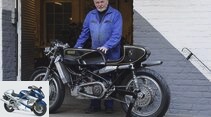

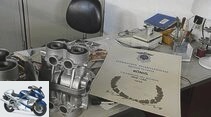

16 pictures
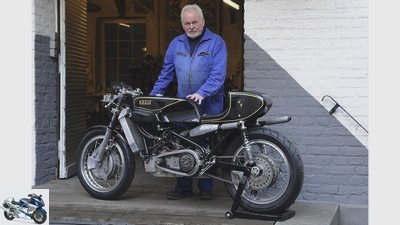
Fred Siemer
1/16
Norbert Schuller knows the sensitive Konig four-cylinder like no other.

Fred Siemer
2/16
Every handle has been in place for over 40 years: Master Schuller assembles a Konig four-cylinder.

Fred Siemer
3/16
Some engine parts, an important document: there is not much that reminds of the great past in the Konig factory.
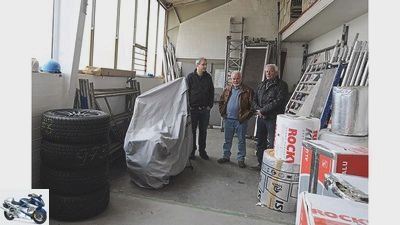
Fred Siemer
4/16
Thorsten Tritscher, Norbert Schuller and Uli Collatz stand where Newcombe and Schuller Renner used to set up.
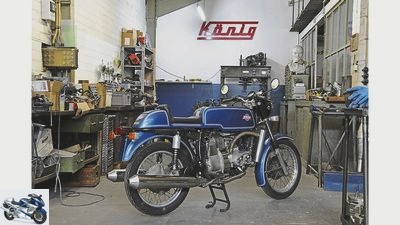
Fred Siemer
5/16
Something like that, some BMW employees (and Dieter Konig) imagined the alternative to the two-valve boxer.
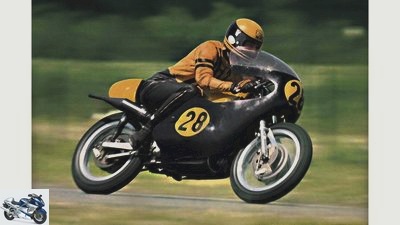
Fred Siemer
6/16
…and would have gone to Suzuki in 1974.
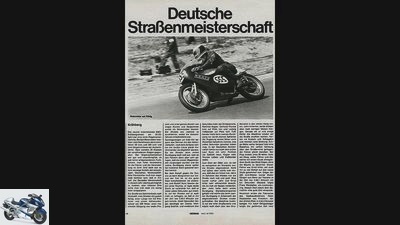
Fred Siemer
7/16
Newcombe had brought the Konig almost to maturity in 1973…
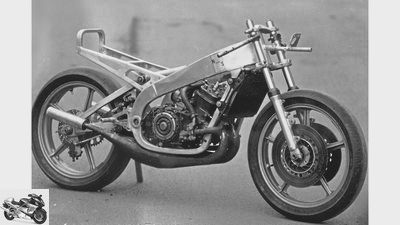
Fred Siemer
8/16
Yamaha’s TZ engine also received a sturdy aluminum box frame. That was enough for the overall JuPo victory.
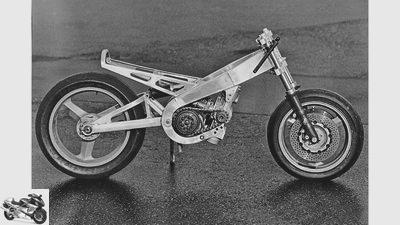
Fred Siemer
9/16
State of the art, in 1984: the Schuller-Konig with an aluminum box frame and an almost vertically inclined motor.
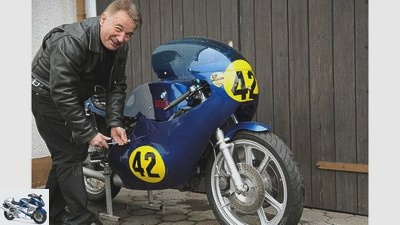
Fred Siemer
10/16
Collector Wolfhart Krischke has taken over the Konig-BMW-Bastard and appreciates the enormous range of services.
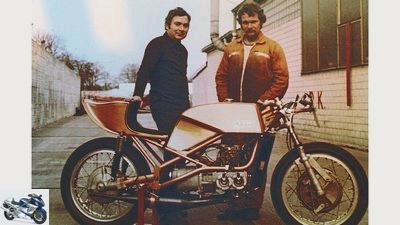
Fred Siemer
11/16
Dieter Konig (left) and Norbert Schuller present the cardan racer with the great tubular frame that is open at the bottom.
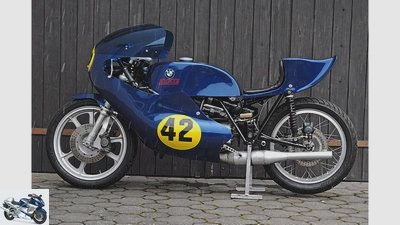
Fred Siemer
12/16
The cardan racer from Konig.
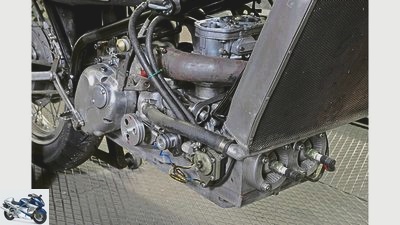
Fred Siemer
13/16
The crankshaft drives the water pump by means of two round belts and the rotary valve by means of a toothed belt deflected by 90 degrees.
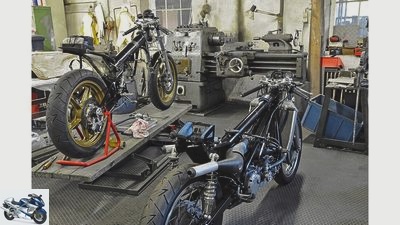
Fred Siemer
14/16
Schuller has already built a number of Konig in his well-equipped workshop. He’ll be happy to do it again if you wish.
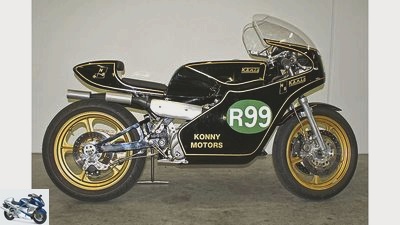
Fred Siemer
15/16
Norbert Schuller’s 500 king, of course with the cantilever arm he designed in the mid-1970s.
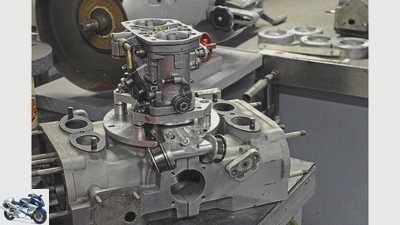
Fred Siemer
16/16
The housing of the rotary plate valve, which is driven by a toothed belt and controls the crank chamber inlets, is located under the double carburetor. Every two cylinders share an inlet.
Sports & scene
Norbert Schuller in portrait
Portrait of Norbert Schuller
King Makers
Content of
He was there when the boat engine manufacturer Konig had great motorcycle times, and he still can’t help it today: Norbert Schuller knows the sensitive four-cylinder two-stroke boxer like no other.
Fred Siemer
06/09/2016
It would happen, everyone who understood anything knew that. It was only thanks to gifted technicians and unique drivers like Giacomo Agostini or Phil Read that MV four-stroke engines continued to collect their titles in the large displacement classes. Behind them, however, the two-stroke engines moved more and more forward around 1970: Close-to-production twins from Suzuki or Triples from Kawasaki made it onto the podium in the half-liter class, often accompanied by minimally drilled-out Yamaha TR 350s, which in turn dominated everything in their class except the World Cup. Even with the sidecars – for example with the courageous Swiss Grand Prix driver Rudi Kurth – the first two-stroke experiments were carried out.
Buy complete article

Norbert Schuller in portrait
King Makers
8 pages) as PDF
€ 2.00
Buy now
At that time, the trained sheet metal fitter Norbert Schuller raged around a few classes lower, namely in the 125 cc in the German junior cup and in the two-stroke cycle, of course. In 1968 he started racing with a Bultaco and meanwhile switched to Maico. Like all his colleagues, he oracle about the Japanese two-stroke offensive in the half-liter class over a beer after work after training. Multi-cylinder, water-cooled, state-of-the-art. In 1970, two Berliners and a New Zealander pushed just such devices through the JuPo paddock. Super slim and visibly light, thanks to the compact two-stroke double boxer handy and incredibly fast. Sometimes something like that failed, but so be it: The New Zealander revealed that the company was still developing – and in 1971 he still easily got the license. From JuPo to Grand Prix: The sensational and tragically too early career of Kim Newcombe took its course.
Successes fueled interest
This lanky kiwi was employed by the Berlin boat engine builder Dieter Konig, who – based on forerunners built by customers – had been taking care of the roadworthy use of the engines he had designed and decorated with many titles on the water and was soon offering coveted kits. Under the Australian privateer John Dodds, the motorcycle, which was further developed by Newcombe, collected some 500 World Championship points in 1971, and around a dozen national riders were promoted. These successes fueled interest, and Konig had to increase staff.
The application of a race-proven high-quality screwdriver who had just been promoted to industrial foreman metal / mechanical engineering came at just the right time, and that’s why Norbert Schuller found himself side by side with Kim Newcombe from autumn 1972. The New Zealander gave his Grand Prix motorcycles the finishing touches for the coming season, together they both assembled five posh motors, otherwise the Rhinelander built a workbench further on complete drive units, combined them with frame, tank and fairing to make kits.
In 1975, Schuller took second place in the JuPo final statement
It is also thanks to his work that seven Konig competed at the 500 World Championship run in Hockenheim in 1973 and at the end of the year, alongside the newcombe, who was posthumously named vice world champion (see “The cardan racer from Konig”) five Konig pilots had won World Championship points. Nationally, there were further nice placements, no wonder: about 25 kits were likely to have left the small plant in Berlin-Charlottenburg for the 1973 season, a total of 50 of them were built by the mid-1970s, plus at least 130 racing engines. However, they only achieved the highest honors in team sport, in 1975 and 1976 when Rolf Steinhausen / Josef Huber won the World Cup.
“It was clear,” says Norbert Schuller in an explanation, at home in his quiet workshop, pumps up the work platform and loosens the panel screws of a 500 series. Calmly. Then, finally: “First of all, after Newcombe’s death, there was no enthusiastic, knowledgeable GP driver to drive the vehicle.” The panel is removed and carefully placed on a table.
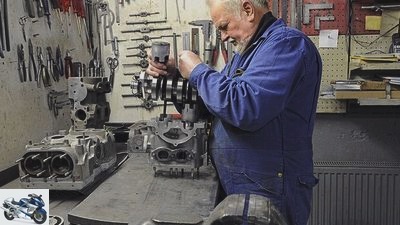
Fred Siemer
Every handle has been in place for over 40 years: Master Schuller assembles a Konig four-cylinder.
“Secondly, Yamaha and Suzuki have now also launched powerful four-cylinder two-stroke engines.” That’s right, that was in 1973 and 1974. “And thirdly,” he grumbles, lifting the tank from the frame, “started with Dieter Konig in 1974, at the latest 1975 the interest in the further development of the chassis and also the engine noticeably decreased. ”That’s right again: Even the initially so enthusiastic team drivers – 18 of 31 championship point collectors drove Konig in 1975, three years later three of 27 – soon relied mainly on more reliable Yamaha -Inline four-cylinder.
After Newcombe’s death, there was initially no factory-supported Konig pilot in the World Cup. In the future, Horst Lahfeld should drive internationally, Norbert Schuller as the new head of the motorcycle racing department should score nationally and at the same time obtain input for further development steps. Part one of this mission worked out fine, because Schuller took second place in the JuPo final account in 1975. And if the gearbox in Bremerhaven hadn’t been torn to pieces, then it would…
Schuller’s great passion: chassis construction
Before the start of the season, he was posted to help the French Christian Leon, whom Dieter Konig had chosen as the new World Cup pilot. The skilled craftsman and the talent of racing drivers. “That didn’t work,” summarizes Norbert Schuller unmoved, but points out fairly that “the Leon” later became famous as a long-distance team with co-pilot Chemarin. “On Honda four-stroke engines.” Which would be an indication of why the Konig often got stuck: the riders had to understand the motorcycle.
“And they needed a better chassis,” interjects Norbert Schuller. Its angular head appears briefly above the central tube of the Konig frame, then it dips down again. His great passion: chassis construction. Early on, he noted carefully where the journey was going, grabbed an accident motorcycle in 1975 and converted it to a cantilever rear swing arm. “Against the will of the boss,” he shakes his head uncomprehendingly. Time for Norbert Schuller to leave the Konig company. In 1976 he started his own business, four years later he moved back to the Rhineland. Classic metal construction. And a lot of motorcycle projects. His welding torch skills are legendary; the early German superbike scene knew how to make use of this and immediately ordered rows of aluminum tanks.

Fred Siemer
Schuller has already built a number of Konig in his well-equipped workshop. He’ll be happy to do it again if you wish.
But King did not let go of him. The potential of this extremely compact and logically constructed engine. A frame made of aluminum box profiles, that’s it. As demonstrated by GP chassis designer Antonio Cobas for Yamaha’s Deltabox. Schuller started in 1983, and the following year his motorcycle started with a guest rider in the DM. The season was disappointing, and now even Norbert Schuller changed camp: his next two aluminum chassis took on Yamaha TZ motors, one of which was the overall winner of the 350 JuPo. He’s telling the story while inspecting the Solex carburetor. And that around 2002 he made a Honda CR 750 replica on behalf of a customer. He liked it a lot, so he treated himself to one and got into veteran racing.
But how do the two kings get onto the lifting platforms? Schuller grins and shrugs his shoulders. “What should you do?” He’s right: you can’t escape a myth that you were so close to creating. The 1973 season of Newcombe, David versus Goliath, all of Germany kept its fingers crossed for the fast constructor, and got drunk on the power of this ingenious engine. Then the Silverstone accident. Newcombe died three days later, on August 14, 1973. “After that there was silence throughout the plant. Empty. Nobody knew what to do next, not even Dieter Konig, ”reports Norbert Schuller.
Help could be waiting in Berlin
There is no personal legacy: “We should have done without Kim anyway.” Schuller looks up again from his work. “He would have gone to Suzuki in 1974,” he continues, “we knew that for sure.” No, no, he probably just wanted to hold the flag high when he played the first VFV season in 2011 with a Konig. He became runner-up in his class – and immediately caught the attention of Heinz Paschen. Everyone knows him as the developer of the powerful BMW Formula 1 engine, but he also has a past as a motorcycle racer, which is precisely why he fell in love with this sparklingly clean 500cc engine. Schuller gave it to him and built a new one himself. With cantilever chassis, of course. He now looks after both of them, and actually a third one is supposed to be in reserve, but the engine is still stuck. A cracked connecting rod must be professionally replaced.
Help could be waiting in Berlin. At Crankshaft Uli Collatz or Thorsten Tritscher. One ex-colleague from Koenig’s racing engine department, the other tuner from kart engines and friend of the Koenig family, today with a workshop in the old factory. You meet in the former assembly hall. Strange atmosphere: a large table littered with kart parts, we forget the workbenches and machines around it. Only an FIM certificate for victory in the World Team Championship reminds of great motorcycle sport. And back there? Norbert Schuller laughs: “I have nothing to do with that.” A Konig engine in the BMW frame! At the time of a Suzuki GT 750 or Kawasaki Mach III, the two-stroke fever also gripped three leading employees at the Berlin BMW plant, and they then created two prototypes with the help of Dieter Konig. The one with 500 cm³ drives again today, the one with 350 cm³ is waiting for a restorer. Norbert Schuller looks at the big motorcycle from top to bottom, then waves it away. A king has to run. He will never stop helping her with this. Not even at 75: “So, Uli, what about the crankshaft now?”
The cardan racer from Konig
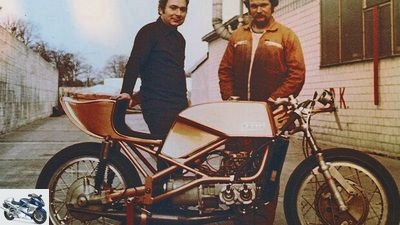
Fred Siemer
Dieter Konig (left) and Norbert Schuller present the cardan racer with the great tubular frame that is open at the bottom.
Like many like-minded people, the Berlin racing driver Horst Fechtner was still on the road in a two-valve BMW in the early 1970s. He was all the more happy to accept the offer of his former teacher Dieter Konig to integrate his powerful two-stroke four-cylinder into the existing framework. There was now a specially cast piece of tunnel between the engine and the gearbox, and the fun could begin. What Fechtner did not know: With this Konig BMW, he had become, so to speak, the test driver of a small secret project. Konig and three senior executives at the Berlin BMW plant had decided to bring such a bastard to the Munich company bosses as a series product. At least not a completely stupid idea, because large-volume two-stroke engines met with great customer interest at the time. But 85 Konig horsepower soon required not only a replacement for the R 50 final drive and gearbox, but also a new frame, and so in 1973 the company boss commissioned his employee Norbert Schuller to create something adequate.
The result may seem like the forerunner of earlier Bimota frames to some and it also worked great, but it didn’t bring any luck: Fechtner had an accident after three or four races. When rebuilding his racer, he wanted a central tubular frame, similar to that of the normal Konig, and so he drove around for a while. In 1976 and 1978 his motorcycle appeared among other riders at World Championship races without causing a sensation there, after which it was used for a long time as a decoration for a driving school shop window. It was only five years ago that the racing machine collector Wolfhart Krischke woke the Konig BMW racer from its slumber and has been moving it to classic races ever since. The two resulting road prototypes were actually shown to the BMW board, and the builders each received a silver watch for their commitment. That’s it.
Kim Newcombe – The mad technician
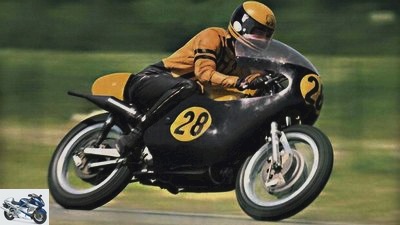
Fred Siemer
After Kim Newcombe’s accident, there was silence throughout the plant. Nobody knew how to go on.
After Yamaha had lost its best rider to Jarno Saarinen’s fatal accident early in the 73s season, Kim Newcombe on the Konig, largely developed by himself, was considered the greatest challenger to Phil Read and Giacomo Agostini on their four- and three-cylinder MV four-strokes . The New Zealander had met Dieter Konig at a boat race in Australia, and the development job appealed to him.
In terms of driving, however, his great passion was motocross, and Newcombe was long toying with a commitment to Maico. But the move to the Swabian province stopped him. With his victory at the Yugoslavia GP, the sympathetic Kiwi electrified all of Germany, the greater the shock after his death, just two months later.
Related articles
-
Portrait of US collector Fred Mork
Blacksmith 27 pictures Blacksmith 1/27 The similarity between human and … Blacksmith 2/27 Blacksmith 3/27 Tons of story (s): whether model kits,…
-
Scene: Portrait of two-stroke fan Scherubl
Siemer 15th pictures Siemer 1/15 The two-stroke fan Gunter Scheruebl transforms old series motorcycles into racing replicas. Siemer 2/15 Scherubl can…
-
Sdun 25th pictures Siemer. 1/25 In focus: Fritz W. Egli. Siemer. 2/25 In focus: Fritz W. Egli. Siemer. 3/25 In focus: Fritz W. Egli. Siemer. 4/25 Thickly…
-
MotoGP – Dorna boss Carmelo Ezpeleta in portrait
2snap Sports & scene Motorsport MotoGP – Dorna boss Carmelo Ezpeleta in portrait MotoGP – Dorna boss Carmelo Ezpeleta in portrait The show master Excited…
-
Siemer 25th pictures Siemer 1/25 Siemer 2/25 A 325 Bultaco from 1979 is certainly one of the strongest that started in Brockhofe, … Siemer 3/25 … the…
-
Portrait of motorcycle collector Wolfgang Lindfeld
Fred Siemer 9 pictures Fred Siemer 1/9 At the collector Wolfgang Linfeld Fred Siemer 2/9 Best of show: The Turbo-Suzuki XN 85 was built from 1983 to 1985…
-
Stutz Sports & scene Portrait: Werner Fallert Portrait: Werner Fallert The Baden motorcycle hobbyist turned 80 in January Content of At the end of the…
-
2snap 6th pictures Friedemann Kirn 1/6 Toni Bou has already won 20 world titles in the trial. Friedemann Kirn 2/6 Superstar without special requests -…
-
Portrait of racing machine collector Wolfhart Krischke
Fred Siemer 14th pictures Fred Siemer 1/14 Wolfhart Krischke’s racing machine collection. Fred Siemer 2/14 King with BMW gearbox and cardan. Fred Siemer…
-
Portrait of designer Uwe Schneider
Siemer 27 pictures Siemer 1/27 Siemer 2/27 Siemer 3/27 Siemer 4/27 Siemer 5/27 The engine and transmission were specifically and very successfully…